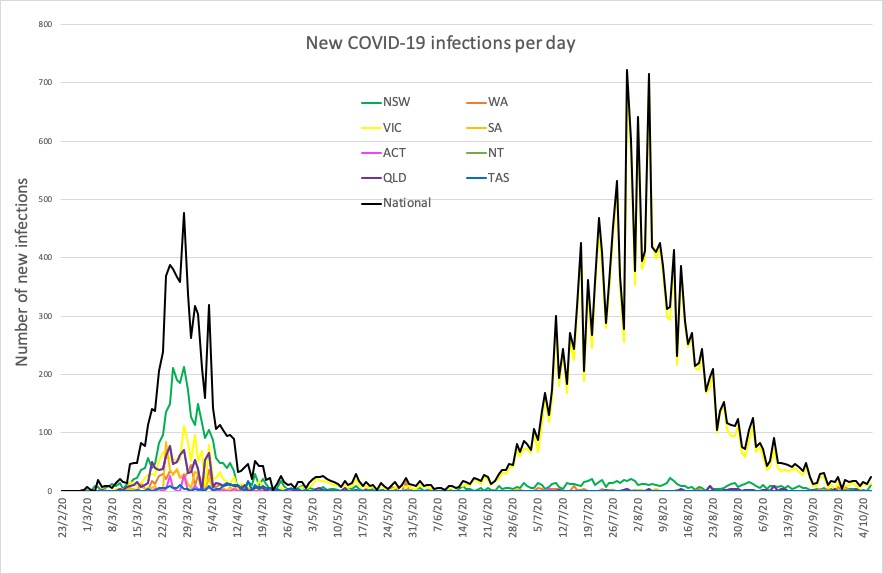Plus the most popular corona conspiracy theories, Sydney wastewater alert and how to flout CDC advice c/o the White House.
Welcome to The Medical Republic’s COVID Catch-Up.
It’s the day’s COVID-19 news in one convenient post. Email bianca@biancanogrady.com with any tips, comments or feedback.
7 October
- Two-thirds of people with non-critical COVID-19 report persistent symptoms two months after diagnosis.
- Trump is a COVID-19 conspiracy-generating machine, according to analysis of infodemic.
- How to catch COVID-19: a guide from the White House.
- Latest confirmed COVID-19 infection numbers from around Australia.
- Two-thirds of patients with mild COVID-19 are still reporting at least one symptom up to two months after testing positive, a study has found.
A study, published in Clinical Microbiology and Infection, followed 150 individuals diagnosed with non-critical COVID-19 for 60 days, with clinical follow-up at 7, 30 and 60 days.
At baseline, 87% of participants reported flu-like symptoms, 59% reported loss of taste or smell, 51% reported fever and 42% reported shortness of breath. At day 30, 68% of patients were still experiencing at least one symptom – the most common being loss of taste or smell – and at day 60 two-thirds reported at least one symptom, although each symptom was less frequently reported at the two-month mark than at the 30-day mark.
At day 30, nearly half of patients reported still feeling sick or even feeling worse than they did at baseline, and at day 60, one-third still felt sick or worse than baseline.
Those who were hospitalised at symptom onset, who were aged 40-60 years, who experienced breathlessness or had abnormal auscultation on admission were more likely to have persisting symptoms.
“We were able to assess the evolution of the disease and demonstrate that even the mildest presentation was associated with medium-term symptoms requiring follow-up,” the authors wrote. “Thus, the COVID-19 pandemic will involve a care burden long after its end.” - Coronavirus conspiracy theories are one of the many unpleasant manifestations of the so-called ‘infodemic’ that has paralleled the COVID-19 pandemic. Now researchers have analysed over 38 million English language articles on the pandemic and concluded that Trump is the biggest single source of COVID-19 misinformation.
The unpublished study from Cornell University, which was reported in the New York Times, found the most prevalent conspiracies were about ‘miracle cures’ (just over 26%) followed by ‘deep state’ conspiracies at 4.4%. After that follows a mind-bending collection of lunacy, including 5G, Bill Gates, bioweapons and even something called ‘bat soup’ that I’m too afraid to investigate.
But the greatest correlation was seen between the word ‘misinformation’ appearing in a COVID-19 article and the article also mentioning Donald Trump, which occurred in nearly 38% of all mentions of COVID-19 misinformation.
“We conclude therefore that the President of the United States was likely the largest driver of the COVID-19 misinformation ‘infodemic’,” the authors wrote. - Meanwhile, the Trump administration is helpfully providing some textbook illustrations of what NOT to do if you would prefer to avoid catching COVID-19. From the Bulletin of Atomic Scientists – the folks who keep that cheerful Doomsday Clock ticking – here’s ‘How to ignore the CDC’s new coronavirus guidelines, in six official White House photos’:
Here’s a handy guide to the updated CDC recommendations about how to protect yourself and others—with helpful depictions by official White House photographers of virus-spreading behaviors that should be avoided. https://t.co/XcimJFZBEh pic.twitter.com/t5JzywAmSz
— Bulletin of the Atomic Scientists (@BulletinAtomic) October 6, 2020
- Western Sydney and the Hawkesbury region are on COVID-19-alert after sewage analysis detected SARS-CoV-2 RNA in wastewater samples. NSW Health has asked residents particularly in North Richmond and West Camden to be on alert for any possible COVID-19 symptoms, however mild, and get tested as soon as possible if they manifest.
The news comes as NSW enters its twelfth day of no community transmission, but records 11 new COVID-19 cases in returned travellers in hotel quarantine.
Here are the latest confirmed COVID-19 infection numbers from around Australia to 9pm Tuesday:
National – 27,174, with 895 deaths
ACT – 113 (0)
NSW – 4246 (11)
NT – 33 (0)
QLD – 1160 (0)
SA – 472 (2)
TAS – 230 (0)
VIC – 20,233 (15)
WA – 687 (0)



